Bob Wingate’s Rolex Vintage Watches Nickname Guide
1- “Buckley” Dial
 The nickname “Buckley” refers to the Rolex watch aficionado and collector John Buckley’s favorite dial. This select dial is pure white with a vivid contrast of black painted on Roman numerals. This dial can be found on vintage Day-Date and Datejust models.
The nickname “Buckley” refers to the Rolex watch aficionado and collector John Buckley’s favorite dial. This select dial is pure white with a vivid contrast of black painted on Roman numerals. This dial can be found on vintage Day-Date and Datejust models.
2- “Patrizzi” Dial
 The “Patrizzi” dial is named after Osvaldo Patrizzi, a famous Swiss watch auctioneer and author. He observed and is credited for recognizing that the three silver rings around the sub-dials of a Model 16520 Zenith Daytona with a black dial sometimes turn a dark brown in color. This color change is possibly due the aging of the protective coating Rolex used on these Daytona dials during mid-1990s. Today the Patrizzi Daytonas are very sought after by collectors.
The “Patrizzi” dial is named after Osvaldo Patrizzi, a famous Swiss watch auctioneer and author. He observed and is credited for recognizing that the three silver rings around the sub-dials of a Model 16520 Zenith Daytona with a black dial sometimes turn a dark brown in color. This color change is possibly due the aging of the protective coating Rolex used on these Daytona dials during mid-1990s. Today the Patrizzi Daytonas are very sought after by collectors.
3- “Paul Newman” Dial
 The famous actor and race driver gives this important Rolex Daytona Cosmograph dial its nickname “Paul Newman.” In the earlier days of collecting wrist watches, these dials were referred to as “Exotic” dial Daytonas. This is due to their different colors and configuration over standard Daytona dials. Through the years, Rolex produced less of these “so called” exotic dials making them exceedingly rare over the more common standard Daytona dials. These exotic dial Daytonas are especially prized by Italian collectors. When Paul Newman was actually seen wearing one of these exotic dial Daytonas during his personal and racing life, the “Paul Newman” nickname for this special Daytona was born. Mr. Newman’s original Daytona sold at auction for more than $17 million U.S. dollars, breaking the record sale at the time for a vintage wristwatch.
The famous actor and race driver gives this important Rolex Daytona Cosmograph dial its nickname “Paul Newman.” In the earlier days of collecting wrist watches, these dials were referred to as “Exotic” dial Daytonas. This is due to their different colors and configuration over standard Daytona dials. Through the years, Rolex produced less of these “so called” exotic dials making them exceedingly rare over the more common standard Daytona dials. These exotic dial Daytonas are especially prized by Italian collectors. When Paul Newman was actually seen wearing one of these exotic dial Daytonas during his personal and racing life, the “Paul Newman” nickname for this special Daytona was born. Mr. Newman’s original Daytona sold at auction for more than $17 million U.S. dollars, breaking the record sale at the time for a vintage wristwatch.
4- “Steve McQueen” Explorer II model 1655
 The “Steve McQueen” name, well known among aficionados for this particular Explorer II model, came from a 1970s advertising campaign launched by Rolex, with the aptly named “King of Cool” film star. At the time of its release, it was considered more of a functional tool watch specifically aimed at Speleologists. It’s also interesting to note that although this Explorer II model 1655 is nicknamed after “Steve McQueen,” the actor never actually wore the watch. He was more likely to be seen wearing a Submariner or GMT-Master.
The “Steve McQueen” name, well known among aficionados for this particular Explorer II model, came from a 1970s advertising campaign launched by Rolex, with the aptly named “King of Cool” film star. At the time of its release, it was considered more of a functional tool watch specifically aimed at Speleologists. It’s also interesting to note that although this Explorer II model 1655 is nicknamed after “Steve McQueen,” the actor never actually wore the watch. He was more likely to be seen wearing a Submariner or GMT-Master.
5- “James Bond” Submariner 6538
 The mega actor Sean Connery played the part of James Bond 007 in the first blockbuster 1962 film “Dr. No.” Sean Connery wore a Rolex stainless steel Submariner model 6538 on the set. Since this was the first Rolex worn in a James Bond film, this model Submariner will always be known as the “James Bond” Submariner. The lack of crown guards and oversized crown on the Submariner 6238 stands out and sets it apart from all later model Submariners, making the model 6238 the original “James Bond” Submariner.
The mega actor Sean Connery played the part of James Bond 007 in the first blockbuster 1962 film “Dr. No.” Sean Connery wore a Rolex stainless steel Submariner model 6538 on the set. Since this was the first Rolex worn in a James Bond film, this model Submariner will always be known as the “James Bond” Submariner. The lack of crown guards and oversized crown on the Submariner 6238 stands out and sets it apart from all later model Submariners, making the model 6238 the original “James Bond” Submariner.
6- “Pussy Galore” GMT-Master 6542
 In the follow-up James Bond film to “Dr. No.,” the 007 1964 film “Goldfinger” actress Honor Blackman wears a late 1950s GMT-Master model 6542 with a bakelite bezel. Playing the role of Pussy Galore in “Goldfinger,” Blackman’s watch receives ample screen time showing its now very famous blue and red bezel, thus nicknamed the “Pussy Galore” GMT-Master.
In the follow-up James Bond film to “Dr. No.,” the 007 1964 film “Goldfinger” actress Honor Blackman wears a late 1950s GMT-Master model 6542 with a bakelite bezel. Playing the role of Pussy Galore in “Goldfinger,” Blackman’s watch receives ample screen time showing its now very famous blue and red bezel, thus nicknamed the “Pussy Galore” GMT-Master.
7- “John Player” Daytona
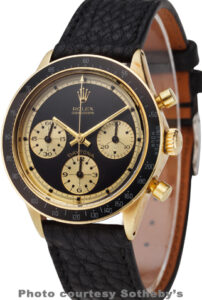 The “John Player Special” refers to the beautiful and rare yellow gold Daytona model 6241. Its clean look with non-screw down pushers, black dial and bezel with gold subdials symbolizes the Lotus Formula 1 racing team colors that was sponsored by the John Player & Sons Special cigarette brand. The gold Daytona 6241 has earned the nickname the “John Player special.”
The “John Player Special” refers to the beautiful and rare yellow gold Daytona model 6241. Its clean look with non-screw down pushers, black dial and bezel with gold subdials symbolizes the Lotus Formula 1 racing team colors that was sponsored by the John Player & Sons Special cigarette brand. The gold Daytona 6241 has earned the nickname the “John Player special.”
8- “Jean-Claude Killy” Dato-Compax Chronograph
 1960’s celebrity professional French Champion alpine skier Jean-Claude Killy became a Rolex brand representative for advertisements by Rolex. He was famous for wearing the Rolex Dato-Compax Chronograph models which gave them the nickname the “Jean-Claude Killy” models. These special Oyster Chronograph Dato-Compax (complications: Day, Month, Date & Chronograph) are very expensive and very sought after by Rolex collectors; especially the model 6036.
1960’s celebrity professional French Champion alpine skier Jean-Claude Killy became a Rolex brand representative for advertisements by Rolex. He was famous for wearing the Rolex Dato-Compax Chronograph models which gave them the nickname the “Jean-Claude Killy” models. These special Oyster Chronograph Dato-Compax (complications: Day, Month, Date & Chronograph) are very expensive and very sought after by Rolex collectors; especially the model 6036.
9- “Bao Dai” Black diamond dial 6062 (no photo at this time)
This rare and exquisite Rolex timepiece “Bao Dai” model 6062 18k triple calendar moonphase with an original and beautiful special black diamond dial belonged to last Emperor of the Nguyen Dynasty of Vietnam. He was granted the title “Bao Dai” (the keeper of greatness) when he was twelve years of age. The “Bao Dai” Rolex 6062 sold in 2017 at a Geneve auction for more than $5 million dollars. At this time, it was the most expensive publicly sold Rolex in history.
10- “Clint Eastwood” GMT-Master 16753
 Mr. Eastwood’s favorite Rolex is his GMT-Master model 16753 brown dial or Root Beer now nicknamed “Clint Eastwood.” Not only was this his daily worn watch for many years; he also wore his GMT-Master in several major films playing different character roles.
Mr. Eastwood’s favorite Rolex is his GMT-Master model 16753 brown dial or Root Beer now nicknamed “Clint Eastwood.” Not only was this his daily worn watch for many years; he also wore his GMT-Master in several major films playing different character roles.
11- “Belmondo” Daytona
 Jean-Paul Belmondo, French legendary film actor and producer from the 1960s forward, was a huge fan of Rolex watches. His favorite Rolex was a 6263 black dial Big Red Daytona with silver subsidiary dials. He has been photographed many times with this favorite Daytona on his wrist. Jean-Paul Belmondo’s best known credits include “Breathless,” “That Man from Rio,” “Pierrot le Fou,” “Borsalino,” and “The Professional.”
Jean-Paul Belmondo, French legendary film actor and producer from the 1960s forward, was a huge fan of Rolex watches. His favorite Rolex was a 6263 black dial Big Red Daytona with silver subsidiary dials. He has been photographed many times with this favorite Daytona on his wrist. Jean-Paul Belmondo’s best known credits include “Breathless,” “That Man from Rio,” “Pierrot le Fou,” “Borsalino,” and “The Professional.”
12- “Bubbleback”

 In the 1940s Rolex introduced their first automatic winding and water-resistant sport watch the “Oyster Perpetual.” The automatic winding rotor mechanism on the back of the movement made this new caliber movement thicker. The case thus had to be designed much thicker than a normal manual winding movement to house this new special automatic rotor movement. Where most watches of the day had snap-on style backs which were not dust or water-resistant, the new “Oyster Perpetual” had a screw-on water-resistant style back with a gasket. These 1940s Rolex watches were quickly nicknamed “Bubbleback” by collectors worldwide. The “Oyster Perpetual” or “Bubbleback” were manufactured in all stainless steel, stainless steel with yellow gold bezel, stainless steel with rose gold bezel, all yellow gold & all rose gold models. These new automatic winding, water-resistant, Rolex watches were very popular with younger and more active people.
In the 1940s Rolex introduced their first automatic winding and water-resistant sport watch the “Oyster Perpetual.” The automatic winding rotor mechanism on the back of the movement made this new caliber movement thicker. The case thus had to be designed much thicker than a normal manual winding movement to house this new special automatic rotor movement. Where most watches of the day had snap-on style backs which were not dust or water-resistant, the new “Oyster Perpetual” had a screw-on water-resistant style back with a gasket. These 1940s Rolex watches were quickly nicknamed “Bubbleback” by collectors worldwide. The “Oyster Perpetual” or “Bubbleback” were manufactured in all stainless steel, stainless steel with yellow gold bezel, stainless steel with rose gold bezel, all yellow gold & all rose gold models. These new automatic winding, water-resistant, Rolex watches were very popular with younger and more active people.
13- “Padellone” Model 5171 Triple-Date Moonphase
 This very rare, low production numbers timepiece has the nickname “Padellone,” derived from the Italian word for “Big Frying Pan." A 38mm case size was considered quite large at the time of its short production period. This complicated timepiece features three apertures displaying phases of the moon, day and month. The date is displayed on the dial’s outer track with a pointer hand.
This very rare, low production numbers timepiece has the nickname “Padellone,” derived from the Italian word for “Big Frying Pan." A 38mm case size was considered quite large at the time of its short production period. This complicated timepiece features three apertures displaying phases of the moon, day and month. The date is displayed on the dial’s outer track with a pointer hand.
14- “President”
 Perhaps the most prestigious and well-recognized Rolex watch ever produced is the famous Day-Date. The bracelet was specially designed for the Day-Date model which was made in four metals: platinum, 18k white gold, 18k rose gold or 18k yellow gold. Lyndon Baines Johnson wore an 18k yellow gold Rolex Day-Date watch during his Presidency in the 1960s, hence the nickname the “President.” The legacy of the President Day-Date continues in production still to this day.
Perhaps the most prestigious and well-recognized Rolex watch ever produced is the famous Day-Date. The bracelet was specially designed for the Day-Date model which was made in four metals: platinum, 18k white gold, 18k rose gold or 18k yellow gold. Lyndon Baines Johnson wore an 18k yellow gold Rolex Day-Date watch during his Presidency in the 1960s, hence the nickname the “President.” The legacy of the President Day-Date continues in production still to this day.
15- “Comex” Submariner & Sea-Dweller

 The French diving Comagnie Maritime d’Expertises or “Comex” specialized in deep diving commercial operations. Comex issued special Rolex diver’s watches to the deep-sea divers beginning during the 1970s. Rolex tested a special prototype Submariner 5513 with a helium escape value. With success of the 5513 testing, Rolex manufactured the first Comex dive watch model 5514 Submariner with the Comex logo on the dial. Comex needed watches that would stand up to extreme depths, pressure chambers, and was able to endure decompression periods. The specialized Comex dive watches were only issued to Comex employees, they were never offered for sale to the public. Each Comex watch had the official employee issued number on the case back (see photo below). Comex Rolex Sea-Dweller models include: 665, 16660 (Triple Six) and 16600. Less than a total 1,000 Comex watches were delivered by Rolex during the years of Comex watch production.
The French diving Comagnie Maritime d’Expertises or “Comex” specialized in deep diving commercial operations. Comex issued special Rolex diver’s watches to the deep-sea divers beginning during the 1970s. Rolex tested a special prototype Submariner 5513 with a helium escape value. With success of the 5513 testing, Rolex manufactured the first Comex dive watch model 5514 Submariner with the Comex logo on the dial. Comex needed watches that would stand up to extreme depths, pressure chambers, and was able to endure decompression periods. The specialized Comex dive watches were only issued to Comex employees, they were never offered for sale to the public. Each Comex watch had the official employee issued number on the case back (see photo below). Comex Rolex Sea-Dweller models include: 665, 16660 (Triple Six) and 16600. Less than a total 1,000 Comex watches were delivered by Rolex during the years of Comex watch production.
16- “Single Red” Submariner
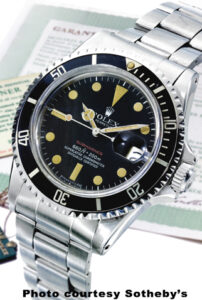 The model 1680 Submariner was known as the first Submariner with a date and cyclops crystal that the word “Submariner” written in a Single Red line. This most likely was to signify this Submariner was a special edition to the Rolex sport watch selection. Collectors affectionately deem this model the “Red Submariner.” All Submariner generations previously manufactured did not have a date or cyclops crystal making the “Red Submariner” very special.
The model 1680 Submariner was known as the first Submariner with a date and cyclops crystal that the word “Submariner” written in a Single Red line. This most likely was to signify this Submariner was a special edition to the Rolex sport watch selection. Collectors affectionately deem this model the “Red Submariner.” All Submariner generations previously manufactured did not have a date or cyclops crystal making the “Red Submariner” very special.
17- “Double Red” Sea-Dweller 1665
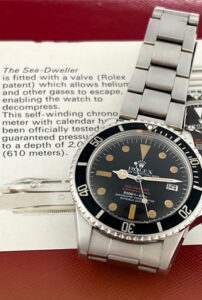 The nickname “Double Red” came from the two lines in striking, bright red text on a matte black dial that reads “Sea-Dweller Submariner 2000.” Years in production: 1967 - 1978.
The nickname “Double Red” came from the two lines in striking, bright red text on a matte black dial that reads “Sea-Dweller Submariner 2000.” Years in production: 1967 - 1978.
18- “Great White” Sea-Dweller

 All white text on the dial of the Sea-Dweller model 1665 replaced the previous editions’ color of red on the “Double Red Sea-Dwellers Submariners” models. First, the Submariner name disappeared. This helped to solidify the perception that the Sea-Dweller was a distinct and separate model from the Submariner in the Rolex lineup. Next was a change from red to white text, hence the name “Great White.”
All white text on the dial of the Sea-Dweller model 1665 replaced the previous editions’ color of red on the “Double Red Sea-Dwellers Submariners” models. First, the Submariner name disappeared. This helped to solidify the perception that the Sea-Dweller was a distinct and separate model from the Submariner in the Rolex lineup. Next was a change from red to white text, hence the name “Great White.”
19- “Rail Dial” Explorer II & Sea-Dweller
 The term Superlative Chronometer Officially Certified is what we focus on here. The letter “C” in Chronometer aligns perfectly up and down with the “C” in Certified making a gap in-between the words know as a “Rail.” The “Rail” dial is only found on the Explorer II models 1655 and 16550, Sea-Dweller model 1665 Great White and 1665 Comex.
The term Superlative Chronometer Officially Certified is what we focus on here. The letter “C” in Chronometer aligns perfectly up and down with the “C” in Certified making a gap in-between the words know as a “Rail.” The “Rail” dial is only found on the Explorer II models 1655 and 16550, Sea-Dweller model 1665 Great White and 1665 Comex.
20- “Triple Six” Sea-Dweller
 The Rolex Sea-Dweller model 16660 was launched in 1978 with a significant improvement to the depth rating over the previous model 1665. The new sapphire crystal (replacing plexiglass), larger case size, and improved design for the Helium Escape Valve mechanism, all enabled the watch to function at the depth of 1220m. Roughly double that of its predecessor.
The Rolex Sea-Dweller model 16660 was launched in 1978 with a significant improvement to the depth rating over the previous model 1665. The new sapphire crystal (replacing plexiglass), larger case size, and improved design for the Helium Escape Valve mechanism, all enabled the watch to function at the depth of 1220m. Roughly double that of its predecessor.
21- “El Cornino” Early 1960s 1675 GMT-Master
 The model 6542, introduced in the mid 1950s, was the first model GMT-Master. This model featured a case with no crown guards to protect the setting crown and a blue/red (Pepsi) bakelite rotatable bezel (see photo A). In the early 1960s, Rolex released the second model GMT-Master, the 1675. The new 1675 model featured a newly designed case with crown guards to protect the setting crown and an aluminum rotatable blue/red (Pepsi) bezel. These crown guards were rather pointed in shape, making this GMT nicknamed the “El Cornino” GMT.
The model 6542, introduced in the mid 1950s, was the first model GMT-Master. This model featured a case with no crown guards to protect the setting crown and a blue/red (Pepsi) bakelite rotatable bezel (see photo A). In the early 1960s, Rolex released the second model GMT-Master, the 1675. The new 1675 model featured a newly designed case with crown guards to protect the setting crown and an aluminum rotatable blue/red (Pepsi) bezel. These crown guards were rather pointed in shape, making this GMT nicknamed the “El Cornino” GMT.
22- “Pepsi” GMT-Master & GMT-Master II
 The blue and red bezel on GMT-Master & GMT-Master II models are nicknamed “Pepsi.” The original model 6542 GMT-Master with the bakelite bezel was introduced in 1954 and was the first “Pepsi” GMT-Master. This long-running pilot’s watch having similarities to the color scheme seen on bottles of PepsiCo’s signature soda gives its iconic nickname. But avid watch enthusiasts know the colors were initially inspired by the colors of Pan American Airways, who gets credit for requesting a watch from Rolex that displays a second time zone. It’s also said that the red and blue colors represent day and night.
The blue and red bezel on GMT-Master & GMT-Master II models are nicknamed “Pepsi.” The original model 6542 GMT-Master with the bakelite bezel was introduced in 1954 and was the first “Pepsi” GMT-Master. This long-running pilot’s watch having similarities to the color scheme seen on bottles of PepsiCo’s signature soda gives its iconic nickname. But avid watch enthusiasts know the colors were initially inspired by the colors of Pan American Airways, who gets credit for requesting a watch from Rolex that displays a second time zone. It’s also said that the red and blue colors represent day and night.
23- “Blueberry Bezel” GMT-Master (no photo at this time)
Some Rolex model 1675 GMT-Masters were produced with an all-blue bezel instead of the traditional blue/red “Pepsi” bezel. The nickname “Blueberry” has been given to these all-blue bezels. Some Rolex collectors believe these were specially made and installed bezels because all-blue bezels on GMT-Masters have never shown up in Rolex catalogs or marketing materials. Needless to say, these “Blueberry” bezels do exist.
24- “Fat Lady” GMT-Master II
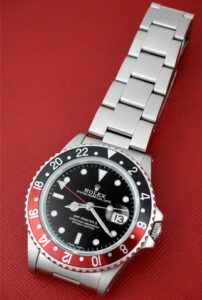 Rolex introduced its first GMT-Master II, the model 16760, in 1983. This model was only offered in stainless steel with a black/red (Coke) bezel. This new model, 16760, featured two independently setting hour hands, thus making it very easy to adjust one hour hand to home time and the other to destination time. The model 16760 was slightly thicker than the later GMT-Master model 16700 and the model 16710 GMT-Master II, earning it the nickname “Fat Lady.”
Rolex introduced its first GMT-Master II, the model 16760, in 1983. This model was only offered in stainless steel with a black/red (Coke) bezel. This new model, 16760, featured two independently setting hour hands, thus making it very easy to adjust one hour hand to home time and the other to destination time. The model 16760 was slightly thicker than the later GMT-Master model 16700 and the model 16710 GMT-Master II, earning it the nickname “Fat Lady.”
25- “Coke” GMT-Master II
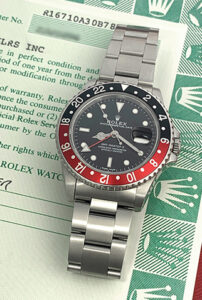 Known universally among Rolex enthusiasts for its black and red bezel, the “Coke” nickname for this Rolex is derived from the model’s bezel, resembling the color scheme on the bottle of the Coca-Cola company’s signature soda. These bezels are found on GMT-Master II models 16760 (Fat Lady) and 16710.
Known universally among Rolex enthusiasts for its black and red bezel, the “Coke” nickname for this Rolex is derived from the model’s bezel, resembling the color scheme on the bottle of the Coca-Cola company’s signature soda. These bezels are found on GMT-Master II models 16760 (Fat Lady) and 16710.
26- “Root Beer” GMT-Master & GMT-Master II
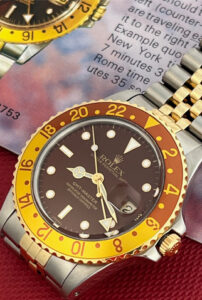 The Rolex “Root Beer” gets this nickname from the brown color dial and bezel combinations on the GMT-Master & GMT-Master II models. The first “Root Beer” dial was introduced on the model 1675 in 1970. The GMT-Master II model 16713 was launched in 1989 with several significant upgrades from its predecessor (Model 1675). The most significant of these improvements for most Rolex fans was the model’s ability to display three time zones. The previous model displayed two. This was made possible by adjustable 12-hour and 24-hour hands. The current version of the iconic Rolex “Root Beer” model is the GMT-Master II 126711CHNR. Some technical attributes of this watch consist of a 3285 caliber and power reserve of 70 hours. A Parachrom hairspring vastly improves shock resistance. Additional changes consist of Oystersteel and Everose gold for the case and bracelet as opposed to stainless steel and yellow gold on previous versions. The bezel was upgraded to a more scratch/fade resistant ceramic material Rolex developed known as Cerachrom.
The Rolex “Root Beer” gets this nickname from the brown color dial and bezel combinations on the GMT-Master & GMT-Master II models. The first “Root Beer” dial was introduced on the model 1675 in 1970. The GMT-Master II model 16713 was launched in 1989 with several significant upgrades from its predecessor (Model 1675). The most significant of these improvements for most Rolex fans was the model’s ability to display three time zones. The previous model displayed two. This was made possible by adjustable 12-hour and 24-hour hands. The current version of the iconic Rolex “Root Beer” model is the GMT-Master II 126711CHNR. Some technical attributes of this watch consist of a 3285 caliber and power reserve of 70 hours. A Parachrom hairspring vastly improves shock resistance. Additional changes consist of Oystersteel and Everose gold for the case and bracelet as opposed to stainless steel and yellow gold on previous versions. The bezel was upgraded to a more scratch/fade resistant ceramic material Rolex developed known as Cerachrom.
27- “Creamy” or “Cream Dial” Explorer II 16550
 This particular Explorer II, model 16550, was introduced in 1985 with two dial options, black & white. The white version became much sought-after by collectors due to the dial appearing as more of an off-white or “Creamy” white. The Explorer II, model 16550, is also known as a traditional model because it was manufactured in-between the earlier Explorer II model 1655 and the later Explorer II model 16570.
This particular Explorer II, model 16550, was introduced in 1985 with two dial options, black & white. The white version became much sought-after by collectors due to the dial appearing as more of an off-white or “Creamy” white. The Explorer II, model 16550, is also known as a traditional model because it was manufactured in-between the earlier Explorer II model 1655 and the later Explorer II model 16570.
28- “Polar” Explorer II 16570, 216570, 26570

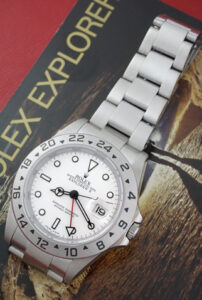 This Explorer II models, 16570 (1989 - 2011), 216570 (2012 - 2021) and the 226570 (2022 - present) were introduced with two dial options, black and white. The white dial version has been dubbed the nickname “Polar” by Rolex collectors.
This Explorer II models, 16570 (1989 - 2011), 216570 (2012 - 2021) and the 226570 (2022 - present) were introduced with two dial options, black and white. The white dial version has been dubbed the nickname “Polar” by Rolex collectors.
29- “Nipple Dial” GMT-Master & Submariner
 “Nipple Dials” are very recognizable by their distinctive dome shape and always made of yellow gold with luminous set in the center of each hour maker. These special dials are only found on vintage 1950s - 1970s all 18k gold and 18k gold and stainless steel GMT-Masters as well as 1970s all 18k gold Submariners.
“Nipple Dials” are very recognizable by their distinctive dome shape and always made of yellow gold with luminous set in the center of each hour maker. These special dials are only found on vintage 1950s - 1970s all 18k gold and 18k gold and stainless steel GMT-Masters as well as 1970s all 18k gold Submariners.
30- “Exclamation Point Dial”
 Many early 1960s Rolex dials had a small dot just below their baton hour marker at the 6:00 position making it appear to be an exclamation point at the bottom of the dial. These Rolex dials are known as “Exclamation Point Dials.” These dials are highly sought after by most Rolex collectors.
Many early 1960s Rolex dials had a small dot just below their baton hour marker at the 6:00 position making it appear to be an exclamation point at the bottom of the dial. These Rolex dials are known as “Exclamation Point Dials.” These dials are highly sought after by most Rolex collectors.
31- “Oyster Sotto” Daytona
 The Italian Rolex collectors nicknamed certain vintage Daytona’s “Oyster Sotto.” “Sotto” in Italian means “under” giving the vintage Daytona Oyster “Sotto” where examples have the word “Oyster” under the words Rolex Cosmograph.
The Italian Rolex collectors nicknamed certain vintage Daytona’s “Oyster Sotto.” “Sotto” in Italian means “under” giving the vintage Daytona Oyster “Sotto” where examples have the word “Oyster” under the words Rolex Cosmograph.
32- “Sigma Dial” Daytona

The Greek symbol “Sigma” “O” is recognized by a pair of these Greek symbols on vintage Rolex dials on the lower portion of the dial under the 6:00 hour marker on either side of “T Swiss T.”
33- “Big Red Dial” Daytona

The nickname “Big Red” is given to the Rolex stainless steel Daytona Cosmograph’s model 6263 & 6265. These two models have “Daytona” written in bold red over the lower subsidiary dial. The models 6263 & 6265 were the last two manual winding models manufactured by Rolex that have Valjoux caliber 72 movement. Production of these two Daytonas ceased in the mid 1980s. The automatic winding Daytona “Zenith” stainless steel model 16520 that replaced the models 6263 & 6265, was introduced in 1988.
34- “Panda Dial” Daytona

The colors and configuration on the dial of this particular Daytona models for many Rolex fans resembles that of a Panda bear’s face. The required specifics for the “Panda” moniker to be applied is a white dial with black sub dials.
35- “Big Eyes” Dial (no photo at this time)
The nickname “Big Eyes” is given to certain vintage Daytona models when their dials have larger than normal subsidiary or sub dials. These larger subsidiary dials are usually found on 6265 and 6263 Daytona models.
36- “Solo Dial”

The nickname “Solo” refers to rather simple dials found on some Rolex Chronographs, like the models 6238 and 6239, without screw-down chronograph pushers. These watches may have only the word “Rolex” printed on the dial.
37- “Unicorn” Daytona (no photo at this time)
The “Unicorn” vintage Daytona model 6265 manufactured in 18k white gold in 1970 is thought to be verified as the only known example of a Daytona in white gold.
38- “Zenith” Daytona
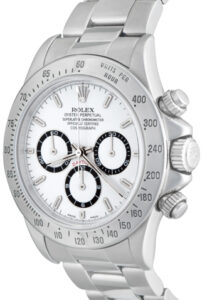
The automatic winding “Zenith” Caliber 4030 movement was placed in the Daytona in 1988. All previous Daytona used the manual winding Valjoux 72 Movement. The “Zenith” automatic winding caliber 4030 with 31 jewels was made by “Zenith” to Rolex specifications. The Zenith Daytona is known as second generation Daytona. The “Zenith” caliber 4030 movement are found in Daytonas from 1988 - 1999. In 2000 launched its first all Rolex Daytona movement, the caliber 4130, which is used presently in their Daytona watches today.
39- “Beach Series” Daytona



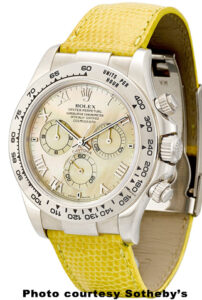
In the early 2000s, Rolex offered a series of Daytonas known as the “Beach Series.” These were all model 11619 and made of 18k white gold. Each of the “Beach Series” was offered with a different color dial: yellow (Mother of Pearl), green (hardstone chalcedony), blue (lacquered), and pink (Mother of Pearl). Each watch included a matching lizard/leather Rolex color strap and Rolex box color matched to the dial color of the watch. These dials are reminiscent of the “Stella” dials released in the 1970s.
40- “Bart Simpson” Submariner

The gilt text dial having similarities to the well-known cartoon character’s hair gives this Submariner model 5512 (1965 - 1966) the “Bart Simpson” nickname. The specific feature on which the name was derived was short lived, making this a rare and collectable timepiece.
41- “Thunderbird” Datejust
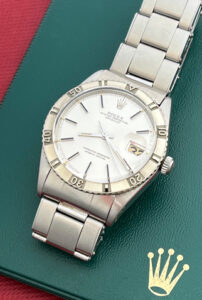
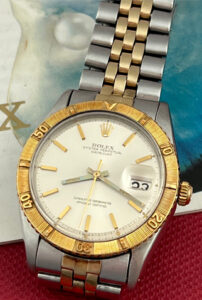
The origin of the Rolex “Thunderbird” name dates back to the late 1950s. Rolex established a relationship with the USAF Air Demonstration Squadron named “Thunderbirds,” and the rest is history. The timepiece’s primary function that appealed to the pilots was the rotating numerical timing bezel Rolex had developed and later named “Turn-O-Graph.” The “Turn-O-Graph” was introduced in 2000. The early “Thunderbird” bezels were produced in white or yellow gold.
42- “Bombay” Case

A “Bombay” Rolex refers to watches with curved twisted lugs that are found on many Rolex Oyster P erpetual watches from the 1950s. The Rolex “Bombay” watches were made in either all steel or all 14k or 18k yellow and rose gold models.
43- “Stella” Dial


“Stella” isn’t actually a nickname but instead the Swiss company’s name that made the bright and colorful dials for Rolex. The Rolex flagship model, the Day-Date, was launched in 1956. This new Day-Date model was only available in precious metals. Great respect was placed on this coveted model by famous celebrities, heads of states and royalty throughout the world. Today the Rolex Day-Date or “President” is recognized as a status symbol by most watch aficionados and known as one of the most popular and best luxury watches ever produced. Dials are generally what stands out on any watch first. Rolex, through the years, made many variations of dials for the Day-Date. Available dial examples include diamond hour markers, stone dials as; Opal, Lapis, Onyx, Ammonite, Coral, all make beautiful and colorful dials. “Stella” color dials were made in a variety of colors such as: green, pink, orange, turquoise, blue, etc. Many “Stella” dials were offered set with round and baguette diamond hour markers. The Stella dial was marketed primarily throughout the 1970s. Rolex collectors around the world covet the famous Day-Date with colorful “Stella” dials.
44- “Stelline Dial”

Rolex produced only two models of a triple calendar with moon phase watch around 1949 - 1953. The model 5171 (Padellone) produced in both stainless steel and 18k gold, and the model 6062. The 6062 produced in 18k is known as “Stelline” in Italian meaning “little star” because the hour markers on the 6062 were tiny gold stars. The 6062 was also produced in stainless steel with arrowhead shaped hour markers. These special, short-lived watches are extremely sought after by Rolex collectors.
45- “Underline” Dial

Vintage Rolex watches with “Underline” Dials have a small horizontal line approximately 5 millimeters in length printed below the text either above or below the hands center. These dials are only found on select models produced around 1962 - 1965. These small horizontal lines are thought to signify the end of radioactive radium luminescence on the dials to a safer luminescent material tritium.
46- “Wide Boy Dial”

The Rolex “Wide Boy Dial” on vintage Day-Date and Datejust models has wider than normal hour markers, giving the watches a great and striking vintage appearance.
47- “Spider Dial” (no photo)
Rolex lacquer coated dials of the 1980s sometimes cracked or crazed giving the dials a spider web-like appearance that was rather unique. This especially was seen when viewing the dial in bright light or from a slight angle. Spider dials, as collectors refer them, are more prevalent on transitional Rolex sport watches with gloss dials from the 1980s.
48- “Tropical Dial”

Cosmetic imperfections can be a big plus on some vintage Rolex watches. One of the most desirable imperfections is known as the “Tropical Dial.” These are dials that have changed their appearance color due to sunlight, heat, humidity, or other environmental aspects. Many of these dials have simply faded due to prolonged exposure to the sunlight. Some Tropical dials that are now brown, were originally black, that have turned to brown. Bright blue Submariner dials from the 1970s sometimes turn purple in color after prolonged exposure to the sun. Some dials change naturally due to the paint pigments or lacquer coatings used at the time and some are changed by the environment. Tropical dials are very sought after by advanced Rolex collectors who appreciate these very interesting variations.
49- “Ghost Bezel”

Before Rolex manufactured their sport watch bezels in ceramic, or in their proprietary material known as Cerachrom, their bezels insert were all made of anodized aluminum. The anodize d aluminum inserts had a color layer added to their surface to make them a “Pepsi,” “Root Beer,” “Coke” or “black” just to name a few color types for the various Rolex sport models. These colored aluminums bezels had a tendency to fade over the years due to exposure to sunlight, salt water and physical contact of clothing, since the bezel was located on the outside of the watch itself. Over time, some of these colored aluminum bezels faded out, hence the nickname “Ghost Bezel.”
50- “Tritium Patina”


In the 1950s Rolex used radioactive material compounds to make their dial hour markers and hands glow in the dark. Soon, the use of radium-based material was found to be dangerous to use on watches. In the early 1960s, Rolex switched to using Tritium, a much less radioactive material. Most vintage Rolex watches up until the 1990s used Tr itium on their dial hour markers and hands to allow them to glow in the dark. When the earlier radioactive compounds aged, they developed a tan or darker patina. When Tritium aged it also showed patina to the hour markers and hands. Collectors enjoy seeing even aged patina on vintage Rolex dials and hands.
51- “Texas T i m e x” President

The great State of Texas experienced its peak oil production in 1972 and was still very strong until the early 2000s. Many Texas oil men displayed their wealth during this time period by wearing an all 18k yellow gold Rolex Day-Date President. Many of these Presidents were “iced out” with custom diamond dials, bezels and bracelets. Some of them were even customized by Texas jewelers with gold nugget look-alike bracelets and heads. The 18k gold President was so popular with the Texas oil men that these watches earned the nickname “Texas T i m e x.”

 The nickname “Buckley” refers to the Rolex watch aficionado and collector John Buckley’s favorite dial. This select dial is pure white with a vivid contrast of black painted on Roman numerals. This dial can be found on vintage Day-Date and Datejust models.
The nickname “Buckley” refers to the Rolex watch aficionado and collector John Buckley’s favorite dial. This select dial is pure white with a vivid contrast of black painted on Roman numerals. This dial can be found on vintage Day-Date and Datejust models. The “Patrizzi” dial is named after Osvaldo Patrizzi, a famous Swiss watch auctioneer and author. He observed and is credited for recognizing that the three silver rings around the sub-dials of a Model 16520 Zenith Daytona with a black dial sometimes turn a dark brown in color. This color change is possibly due the aging of the protective coating Rolex used on these Daytona dials during mid-1990s. Today the Patrizzi Daytonas are very sought after by collectors.
The “Patrizzi” dial is named after Osvaldo Patrizzi, a famous Swiss watch auctioneer and author. He observed and is credited for recognizing that the three silver rings around the sub-dials of a Model 16520 Zenith Daytona with a black dial sometimes turn a dark brown in color. This color change is possibly due the aging of the protective coating Rolex used on these Daytona dials during mid-1990s. Today the Patrizzi Daytonas are very sought after by collectors. The famous actor and race driver gives this important Rolex Daytona Cosmograph dial its nickname “Paul Newman.” In the earlier days of collecting wrist watches, these dials were referred to as “Exotic” dial Daytonas. This is due to their different colors and configuration over standard Daytona dials. Through the years, Rolex produced less of these “so called” exotic dials making them exceedingly rare over the more common standard Daytona dials. These exotic dial Daytonas are especially prized by Italian collectors. When Paul Newman was actually seen wearing one of these exotic dial Daytonas during his personal and racing life, the “Paul Newman” nickname for this special Daytona was born. Mr. Newman’s original Daytona sold at auction for more than $17 million U.S. dollars, breaking the record sale at the time for a vintage wristwatch.
The famous actor and race driver gives this important Rolex Daytona Cosmograph dial its nickname “Paul Newman.” In the earlier days of collecting wrist watches, these dials were referred to as “Exotic” dial Daytonas. This is due to their different colors and configuration over standard Daytona dials. Through the years, Rolex produced less of these “so called” exotic dials making them exceedingly rare over the more common standard Daytona dials. These exotic dial Daytonas are especially prized by Italian collectors. When Paul Newman was actually seen wearing one of these exotic dial Daytonas during his personal and racing life, the “Paul Newman” nickname for this special Daytona was born. Mr. Newman’s original Daytona sold at auction for more than $17 million U.S. dollars, breaking the record sale at the time for a vintage wristwatch. The “Steve McQueen” name, well known among aficionados for this particular Explorer II model, came from a 1970s advertising campaign launched by Rolex, with the aptly named “King of Cool” film star. At the time of its release, it was considered more of a functional tool watch specifically aimed at Speleologists. It’s also interesting to note that although this Explorer II model 1655 is nicknamed after “Steve McQueen,” the actor never actually wore the watch. He was more likely to be seen wearing a Submariner or GMT-Master.
The “Steve McQueen” name, well known among aficionados for this particular Explorer II model, came from a 1970s advertising campaign launched by Rolex, with the aptly named “King of Cool” film star. At the time of its release, it was considered more of a functional tool watch specifically aimed at Speleologists. It’s also interesting to note that although this Explorer II model 1655 is nicknamed after “Steve McQueen,” the actor never actually wore the watch. He was more likely to be seen wearing a Submariner or GMT-Master. In the follow-up James Bond film to “Dr. No.,” the 007 1964 film “Goldfinger” actress Honor Blackman wears a late 1950s GMT-Master model 6542 with a bakelite bezel. Playing the role of Pussy Galore in “Goldfinger,” Blackman’s watch receives ample screen time showing its now very famous blue and red bezel, thus nicknamed the “Pussy Galore” GMT-Master.
In the follow-up James Bond film to “Dr. No.,” the 007 1964 film “Goldfinger” actress Honor Blackman wears a late 1950s GMT-Master model 6542 with a bakelite bezel. Playing the role of Pussy Galore in “Goldfinger,” Blackman’s watch receives ample screen time showing its now very famous blue and red bezel, thus nicknamed the “Pussy Galore” GMT-Master. The “John Player Special” refers to the beautiful and rare yellow gold Daytona model 6241. Its clean look with non-screw down pushers, black dial and bezel with gold subdials symbolizes the Lotus Formula 1 racing team colors that was sponsored by the John Player & Sons Special cigarette brand. The gold Daytona 6241 has earned the nickname the “John Player special.”
The “John Player Special” refers to the beautiful and rare yellow gold Daytona model 6241. Its clean look with non-screw down pushers, black dial and bezel with gold subdials symbolizes the Lotus Formula 1 racing team colors that was sponsored by the John Player & Sons Special cigarette brand. The gold Daytona 6241 has earned the nickname the “John Player special.” 1960’s celebrity professional French Champion alpine skier Jean-Claude Killy became a Rolex brand representative for advertisements by Rolex. He was famous for wearing the Rolex Dato-Compax Chronograph models which gave them the nickname the “Jean-Claude Killy” models. These special Oyster Chronograph Dato-Compax (complications: Day, Month, Date & Chronograph) are very expensive and very sought after by Rolex collectors; especially the model 6036.
1960’s celebrity professional French Champion alpine skier Jean-Claude Killy became a Rolex brand representative for advertisements by Rolex. He was famous for wearing the Rolex Dato-Compax Chronograph models which gave them the nickname the “Jean-Claude Killy” models. These special Oyster Chronograph Dato-Compax (complications: Day, Month, Date & Chronograph) are very expensive and very sought after by Rolex collectors; especially the model 6036. Mr. Eastwood’s favorite Rolex is his GMT-Master model 16753 brown dial or Root Beer now nicknamed “Clint Eastwood.” Not only was this his daily worn watch for many years; he also wore his GMT-Master in several major films playing different character roles.
Mr. Eastwood’s favorite Rolex is his GMT-Master model 16753 brown dial or Root Beer now nicknamed “Clint Eastwood.” Not only was this his daily worn watch for many years; he also wore his GMT-Master in several major films playing different character roles. Jean-Paul Belmondo, French legendary film actor and producer from the 1960s forward, was a huge fan of Rolex watches. His favorite Rolex was a 6263 black dial Big Red Daytona with silver subsidiary dials. He has been photographed many times with this favorite Daytona on his wrist. Jean-Paul Belmondo’s best known credits include “Breathless,” “That Man from Rio,” “Pierrot le Fou,” “Borsalino,” and “The Professional.”
Jean-Paul Belmondo, French legendary film actor and producer from the 1960s forward, was a huge fan of Rolex watches. His favorite Rolex was a 6263 black dial Big Red Daytona with silver subsidiary dials. He has been photographed many times with this favorite Daytona on his wrist. Jean-Paul Belmondo’s best known credits include “Breathless,” “That Man from Rio,” “Pierrot le Fou,” “Borsalino,” and “The Professional.”
 In the 1940s Rolex introduced their first automatic winding and water-resistant sport watch the “Oyster Perpetual.” The automatic winding rotor mechanism on the back of the movement made this new caliber movement thicker. The case thus had to be designed much thicker than a normal manual winding movement to house this new special automatic rotor movement. Where most watches of the day had snap-on style backs which were not dust or water-resistant, the new “Oyster Perpetual” had a screw-on water-resistant style back with a gasket. These 1940s Rolex watches were quickly nicknamed “Bubbleback” by collectors worldwide. The “Oyster Perpetual” or “Bubbleback” were manufactured in all stainless steel, stainless steel with yellow gold bezel, stainless steel with rose gold bezel, all yellow gold & all rose gold models. These new automatic winding, water-resistant, Rolex watches were very popular with younger and more active people.
In the 1940s Rolex introduced their first automatic winding and water-resistant sport watch the “Oyster Perpetual.” The automatic winding rotor mechanism on the back of the movement made this new caliber movement thicker. The case thus had to be designed much thicker than a normal manual winding movement to house this new special automatic rotor movement. Where most watches of the day had snap-on style backs which were not dust or water-resistant, the new “Oyster Perpetual” had a screw-on water-resistant style back with a gasket. These 1940s Rolex watches were quickly nicknamed “Bubbleback” by collectors worldwide. The “Oyster Perpetual” or “Bubbleback” were manufactured in all stainless steel, stainless steel with yellow gold bezel, stainless steel with rose gold bezel, all yellow gold & all rose gold models. These new automatic winding, water-resistant, Rolex watches were very popular with younger and more active people. This very rare, low production numbers timepiece has the nickname “Padellone,” derived from the Italian word for “Big Frying Pan." A 38mm case size was considered quite large at the time of its short production period. This complicated timepiece features three apertures displaying phases of the moon, day and month. The date is displayed on the dial’s outer track with a pointer hand.
This very rare, low production numbers timepiece has the nickname “Padellone,” derived from the Italian word for “Big Frying Pan." A 38mm case size was considered quite large at the time of its short production period. This complicated timepiece features three apertures displaying phases of the moon, day and month. The date is displayed on the dial’s outer track with a pointer hand. Perhaps the most prestigious and well-recognized Rolex watch ever produced is the famous Day-Date. The bracelet was specially designed for the Day-Date model which was made in four metals: platinum, 18k white gold, 18k rose gold or 18k yellow gold. Lyndon Baines Johnson wore an 18k yellow gold Rolex Day-Date watch during his Presidency in the 1960s, hence the nickname the “President.” The legacy of the President Day-Date continues in production still to this day.
Perhaps the most prestigious and well-recognized Rolex watch ever produced is the famous Day-Date. The bracelet was specially designed for the Day-Date model which was made in four metals: platinum, 18k white gold, 18k rose gold or 18k yellow gold. Lyndon Baines Johnson wore an 18k yellow gold Rolex Day-Date watch during his Presidency in the 1960s, hence the nickname the “President.” The legacy of the President Day-Date continues in production still to this day.
 The French diving Comagnie Maritime d’Expertises or “Comex” specialized in deep diving commercial operations. Comex issued special Rolex diver’s watches to the deep-sea divers beginning during the 1970s. Rolex tested a special prototype Submariner 5513 with a helium escape value. With success of the 5513 testing, Rolex manufactured the first Comex dive watch model 5514 Submariner with the Comex logo on the dial. Comex needed watches that would stand up to extreme depths, pressure chambers, and was able to endure decompression periods. The specialized Comex dive watches were only issued to Comex employees, they were never offered for sale to the public. Each Comex watch had the official employee issued number on the case back (see photo below). Comex Rolex Sea-Dweller models include: 665, 16660 (Triple Six) and 16600. Less than a total 1,000 Comex watches were delivered by Rolex during the years of Comex watch production.
The French diving Comagnie Maritime d’Expertises or “Comex” specialized in deep diving commercial operations. Comex issued special Rolex diver’s watches to the deep-sea divers beginning during the 1970s. Rolex tested a special prototype Submariner 5513 with a helium escape value. With success of the 5513 testing, Rolex manufactured the first Comex dive watch model 5514 Submariner with the Comex logo on the dial. Comex needed watches that would stand up to extreme depths, pressure chambers, and was able to endure decompression periods. The specialized Comex dive watches were only issued to Comex employees, they were never offered for sale to the public. Each Comex watch had the official employee issued number on the case back (see photo below). Comex Rolex Sea-Dweller models include: 665, 16660 (Triple Six) and 16600. Less than a total 1,000 Comex watches were delivered by Rolex during the years of Comex watch production. The model 1680 Submariner was known as the first Submariner with a date and cyclops crystal that the word “Submariner” written in a Single Red line. This most likely was to signify this Submariner was a special edition to the Rolex sport watch selection. Collectors affectionately deem this model the “Red Submariner.” All Submariner generations previously manufactured did not have a date or cyclops crystal making the “Red Submariner” very special.
The model 1680 Submariner was known as the first Submariner with a date and cyclops crystal that the word “Submariner” written in a Single Red line. This most likely was to signify this Submariner was a special edition to the Rolex sport watch selection. Collectors affectionately deem this model the “Red Submariner.” All Submariner generations previously manufactured did not have a date or cyclops crystal making the “Red Submariner” very special. The nickname “Double Red” came from the two lines in striking, bright red text on a matte black dial that reads “Sea-Dweller Submariner 2000.” Years in production: 1967 - 1978.
The nickname “Double Red” came from the two lines in striking, bright red text on a matte black dial that reads “Sea-Dweller Submariner 2000.” Years in production: 1967 - 1978.
 All white text on the dial of the Sea-Dweller model 1665 replaced the previous editions’ color of red on the “Double Red Sea-Dwellers Submariners” models. First, the Submariner name disappeared. This helped to solidify the perception that the Sea-Dweller was a distinct and separate model from the Submariner in the Rolex lineup. Next was a change from red to white text, hence the name “Great White.”
All white text on the dial of the Sea-Dweller model 1665 replaced the previous editions’ color of red on the “Double Red Sea-Dwellers Submariners” models. First, the Submariner name disappeared. This helped to solidify the perception that the Sea-Dweller was a distinct and separate model from the Submariner in the Rolex lineup. Next was a change from red to white text, hence the name “Great White.” The term Superlative Chronometer Officially Certified is what we focus on here. The letter “C” in Chronometer aligns perfectly up and down with the “C” in Certified making a gap in-between the words know as a “Rail.” The “Rail” dial is only found on the Explorer II models 1655 and 16550, Sea-Dweller model 1665 Great White and 1665 Comex.
The term Superlative Chronometer Officially Certified is what we focus on here. The letter “C” in Chronometer aligns perfectly up and down with the “C” in Certified making a gap in-between the words know as a “Rail.” The “Rail” dial is only found on the Explorer II models 1655 and 16550, Sea-Dweller model 1665 Great White and 1665 Comex. The Rolex Sea-Dweller model 16660 was launched in 1978 with a significant improvement to the depth rating over the previous model 1665. The new sapphire crystal (replacing plexiglass), larger case size, and improved design for the Helium Escape Valve mechanism, all enabled the watch to function at the depth of 1220m. Roughly double that of its predecessor.
The Rolex Sea-Dweller model 16660 was launched in 1978 with a significant improvement to the depth rating over the previous model 1665. The new sapphire crystal (replacing plexiglass), larger case size, and improved design for the Helium Escape Valve mechanism, all enabled the watch to function at the depth of 1220m. Roughly double that of its predecessor. The model 6542, introduced in the mid 1950s, was the first model GMT-Master. This model featured a case with no crown guards to protect the setting crown and a blue/red (Pepsi) bakelite rotatable bezel (see photo A). In the early 1960s, Rolex released the second model GMT-Master, the 1675. The new 1675 model featured a newly designed case with crown guards to protect the setting crown and an aluminum rotatable blue/red (Pepsi) bezel. These crown guards were rather pointed in shape, making this GMT nicknamed the “El Cornino” GMT.
The model 6542, introduced in the mid 1950s, was the first model GMT-Master. This model featured a case with no crown guards to protect the setting crown and a blue/red (Pepsi) bakelite rotatable bezel (see photo A). In the early 1960s, Rolex released the second model GMT-Master, the 1675. The new 1675 model featured a newly designed case with crown guards to protect the setting crown and an aluminum rotatable blue/red (Pepsi) bezel. These crown guards were rather pointed in shape, making this GMT nicknamed the “El Cornino” GMT. The blue and red bezel on GMT-Master & GMT-Master II models are nicknamed “Pepsi.” The original model 6542 GMT-Master with the bakelite bezel was introduced in 1954 and was the first “Pepsi” GMT-Master. This long-running pilot’s watch having similarities to the color scheme seen on bottles of PepsiCo’s signature soda gives its iconic nickname. But avid watch enthusiasts know the colors were initially inspired by the colors of Pan American Airways, who gets credit for requesting a watch from Rolex that displays a second time zone. It’s also said that the red and blue colors represent day and night.
The blue and red bezel on GMT-Master & GMT-Master II models are nicknamed “Pepsi.” The original model 6542 GMT-Master with the bakelite bezel was introduced in 1954 and was the first “Pepsi” GMT-Master. This long-running pilot’s watch having similarities to the color scheme seen on bottles of PepsiCo’s signature soda gives its iconic nickname. But avid watch enthusiasts know the colors were initially inspired by the colors of Pan American Airways, who gets credit for requesting a watch from Rolex that displays a second time zone. It’s also said that the red and blue colors represent day and night. Rolex introduced its first GMT-Master II, the model 16760, in 1983. This model was only offered in stainless steel with a black/red (Coke) bezel. This new model, 16760, featured two independently setting hour hands, thus making it very easy to adjust one hour hand to home time and the other to destination time. The model 16760 was slightly thicker than the later GMT-Master model 16700 and the model 16710 GMT-Master II, earning it the nickname “Fat Lady.”
Rolex introduced its first GMT-Master II, the model 16760, in 1983. This model was only offered in stainless steel with a black/red (Coke) bezel. This new model, 16760, featured two independently setting hour hands, thus making it very easy to adjust one hour hand to home time and the other to destination time. The model 16760 was slightly thicker than the later GMT-Master model 16700 and the model 16710 GMT-Master II, earning it the nickname “Fat Lady.” Known universally among Rolex enthusiasts for its black and red bezel, the “Coke” nickname for this Rolex is derived from the model’s bezel, resembling the color scheme on the bottle of the Coca-Cola company’s signature soda. These bezels are found on GMT-Master II models 16760 (Fat Lady) and 16710.
Known universally among Rolex enthusiasts for its black and red bezel, the “Coke” nickname for this Rolex is derived from the model’s bezel, resembling the color scheme on the bottle of the Coca-Cola company’s signature soda. These bezels are found on GMT-Master II models 16760 (Fat Lady) and 16710. The Rolex “Root Beer” gets this nickname from the brown color dial and bezel combinations on the GMT-Master & GMT-Master II models. The first “Root Beer” dial was introduced on the model 1675 in 1970. The GMT-Master II model 16713 was launched in 1989 with several significant upgrades from its predecessor (Model 1675). The most significant of these improvements for most Rolex fans was the model’s ability to display three time zones. The previous model displayed two. This was made possible by adjustable 12-hour and 24-hour hands. The current version of the iconic Rolex “Root Beer” model is the GMT-Master II 126711CHNR. Some technical attributes of this watch consist of a 3285 caliber and power reserve of 70 hours. A Parachrom hairspring vastly improves shock resistance. Additional changes consist of Oystersteel and Everose gold for the case and bracelet as opposed to stainless steel and yellow gold on previous versions. The bezel was upgraded to a more scratch/fade resistant ceramic material Rolex developed known as Cerachrom.
The Rolex “Root Beer” gets this nickname from the brown color dial and bezel combinations on the GMT-Master & GMT-Master II models. The first “Root Beer” dial was introduced on the model 1675 in 1970. The GMT-Master II model 16713 was launched in 1989 with several significant upgrades from its predecessor (Model 1675). The most significant of these improvements for most Rolex fans was the model’s ability to display three time zones. The previous model displayed two. This was made possible by adjustable 12-hour and 24-hour hands. The current version of the iconic Rolex “Root Beer” model is the GMT-Master II 126711CHNR. Some technical attributes of this watch consist of a 3285 caliber and power reserve of 70 hours. A Parachrom hairspring vastly improves shock resistance. Additional changes consist of Oystersteel and Everose gold for the case and bracelet as opposed to stainless steel and yellow gold on previous versions. The bezel was upgraded to a more scratch/fade resistant ceramic material Rolex developed known as Cerachrom. This particular Explorer II, model 16550, was introduced in 1985 with two dial options, black & white. The white version became much sought-after by collectors due to the dial appearing as more of an off-white or “Creamy” white. The Explorer II, model 16550, is also known as a traditional model because it was manufactured in-between the earlier Explorer II model 1655 and the later Explorer II model 16570.
This particular Explorer II, model 16550, was introduced in 1985 with two dial options, black & white. The white version became much sought-after by collectors due to the dial appearing as more of an off-white or “Creamy” white. The Explorer II, model 16550, is also known as a traditional model because it was manufactured in-between the earlier Explorer II model 1655 and the later Explorer II model 16570.
 This Explorer II models, 16570 (1989 - 2011), 216570 (2012 - 2021) and the 226570 (2022 - present) were introduced with two dial options, black and white. The white dial version has been dubbed the nickname “Polar” by Rolex collectors.
This Explorer II models, 16570 (1989 - 2011), 216570 (2012 - 2021) and the 226570 (2022 - present) were introduced with two dial options, black and white. The white dial version has been dubbed the nickname “Polar” by Rolex collectors. “Nipple Dials” are very recognizable by their distinctive dome shape and always made of yellow gold with luminous set in the center of each hour maker. These special dials are only found on vintage 1950s - 1970s all 18k gold and 18k gold and stainless steel GMT-Masters as well as 1970s all 18k gold Submariners.
“Nipple Dials” are very recognizable by their distinctive dome shape and always made of yellow gold with luminous set in the center of each hour maker. These special dials are only found on vintage 1950s - 1970s all 18k gold and 18k gold and stainless steel GMT-Masters as well as 1970s all 18k gold Submariners. Many early 1960s Rolex dials had a small dot just below their baton hour marker at the 6:00 position making it appear to be an exclamation point at the bottom of the dial. These Rolex dials are known as “Exclamation Point Dials.” These dials are highly sought after by most Rolex collectors.
Many early 1960s Rolex dials had a small dot just below their baton hour marker at the 6:00 position making it appear to be an exclamation point at the bottom of the dial. These Rolex dials are known as “Exclamation Point Dials.” These dials are highly sought after by most Rolex collectors. The Italian Rolex collectors nicknamed certain vintage Daytona’s “Oyster Sotto.” “Sotto” in Italian means “under” giving the vintage Daytona Oyster “Sotto” where examples have the word “Oyster” under the words Rolex Cosmograph.
The Italian Rolex collectors nicknamed certain vintage Daytona’s “Oyster Sotto.” “Sotto” in Italian means “under” giving the vintage Daytona Oyster “Sotto” where examples have the word “Oyster” under the words Rolex Cosmograph.





























